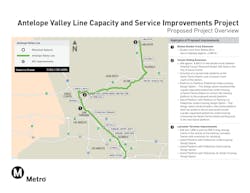L.A. Metro Board approves FEIR for Antelope Valley Line improvements
The Final Environmental Impact Report (EIR) or the Antelope Valley Line (AVL) Capacity and Service Improvements Program, which proposes three new capital improvements and aims to improve service and reliability along the 76.6-mile corridor, has been approved by the Los Angeles County Metropolitan Transportation Authority (L.A. Metro) Board of Directors.
"The proposed Antelope Valley Line improvements helps the region to meet its transit needs in light of anticipated substantial population and employment growth in the North Los Angeles County region over the next 20 years," said L.A. Metro Board Chair and Chair of the Board of Supervisors Hilda L. Solis. "This rail corridor plays a critical role in connecting communities in the North L.A. County with downtown Los Angeles and all the cities in between."
The project’s goal is to enable regular interval scheduling of 30 minutes of bi-directional commuter rail service from Los Angeles Union Station to the City of Santa Clarita and hourly service to the end of the AVL corridor in the city of Lancaster. The existing commuter rail service patterns range from 30 minutes during peak service to up to two hours during off-peak service hours.
"Over 3 million people and 11 million jobs fall within the Antelope Valley Line corridor and upgrading this line has been one of my highest transportation priorities over the past five years. The approval of the environmental studies is a big step forward and moves us toward realizing that goal," said LA County Supervisor and Metro Board Member Kathryn Barger. "The Antelope Valley Line will play a big and important role in the future of Los Angeles County’s housing and employment opportunities."
"I’m excited we certified the Antelope Valley Line Capacity and Service Improvements final EIR," said Metrolink Board Chair Ara Najarian, who is also a member of the Metro Board of Directors and Glendale City Council. "This project will improve service frequency and reliability along the rail corridor between Lancaster, Santa Clarita, the San Fernando Valley, Glendale and downtown Los Angeles. This milestone brings Metrolink riders closer to increased mobility and access to job centers and tourist destinations. This action expands on our commitment to improved service frequency and reliability along this vital corridor."
The Antelope Valley Line improvements are part of Metrolink’s Southern California Optimized Rail Expansion (SCORE) Program, an ambitious capital project initiative that will meet the state's goals to reduce greenhouse gases and improve access to affordable housing and economic prosperity.
"The Newsom Administration is investing in upgrading the Antelope Valley Line to expand service as well as assess the feasibility of zero-emission rail technology," said David S. Kim, Secretary of the California State Transportation Agency (CalSTA). "This is a lynchpin project to a cleaner, more connected statewide transportation system that will reduce greenhouse gas emissions and our dependence on driving, and this action by the Metro Board represents an important step."
The three proposed capital improvements under study include the Balboa Double Track Extension located in the city of Los Angeles, the Canyon Siding Extension located in the City of Santa Clarita and the Lancaster Terminal Improvements located in the city of Lancaster.
L.A. Metro demographics maps show that one in three Antelope Valley residents live in Equity Focus Communities (EFC), a designation that factors in household income, race and ethnicity and low-vehicle ownership. The enhanced Antelope Valley line, which runs through seven EFCs, according to U.S. Census Bureau statistics, will improve mobility options throughout the region.
"Improving the customer experience with more trains and better reliability along this important corridor will have the greatest impact on increasing access to opportunity and providing real benefits for these communities that have waited a long time for increased transit options," said L.A. Metro CEO Stephanie N. Wiggins "We are committed to providing equitable transportation solutions with our Metrolink partners as we work on fully realizing this line’s potential as a regionally significant mobility enhancement for Los Angeles County."
Metro will continue to work with Metrolink and other stakeholders to complete the final design and prepare to implement the construction of these improvements as early as 2028-2030.


